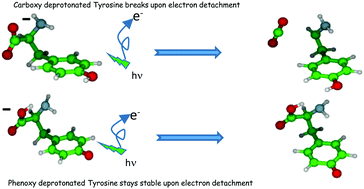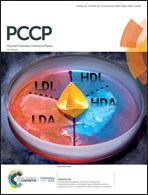Photodetachment of deprotonated aromatic amino acids: stability of the dehydrogenated radical depends on the deprotonation site†
Abstract
While aromatic amino acids in their deprotonated form have been well characterized by IR and photoelectron spectroscopies, no information is available on the neutral dehydrogenated radicals and, in particular, on their stability when the deprotonation site is changed. This is investigated by observing the neutral fragment issued from either simple photodetachment or dissociative photodetachment of the deprotonated aromatic amino acids phenylalanine, tyrosine, and tryptophan. We show that the dehydrogenated radicals of aromatic amino acids produced upon photodetachment of molecules deprotonated on the carbonyl group dissociate without barrier, leading to the formation of CO2 and a radical amine. However, when the system is deprotonated on functional groups located on the chromophore, the radicals produced by photodetachment are stable, indicating the important photostabilizing role played by functional groups.

- This article is part of the themed collection: 2019 PCCP HOT Articles


 Please wait while we load your content...
Please wait while we load your content...